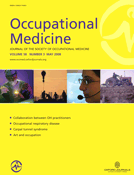-
PDF
- Split View
-
Views
-
Cite
Cite
Chris Stenton, The MRC breathlessness scale, Occupational Medicine, Volume 58, Issue 3, May 2008, Pages 226–227, https://doi.org/10.1093/occmed/kqm162
Close - Share Icon Share
Brief history
Breathlessness is a complex subjective sensation that is an important feature of cardio-respiratory disease. It is difficult to quantify but it is necessary to do that if the symptoms of a particular group are to be summarized and compared with others. Fletcher and co-workers addressed this problem when studying the respiratory problems of Welsh coal miners at the Medical Research Council Pneumoconiosis Unit in the 1940s. They devised a short questionnaire that allowed a numeric value to be placed on each subject's exercise capacity. The questions were first published in 1952 [1] and rapidly developed into the MRC breathlessness scale [2]. They have been in widespread use since then.
Description
The MRC breathlessness scale (Figure 1) comprises five statements that describe almost the entire range of respiratory disability from none (Grade 1) to almost complete incapacity (Grade 5). It can be self-administered by asking subjects to choose a phrase that best describes their condition, e.g. ‘I only get breathless with strenuous exertion’ (Grade 1) or ‘I am too breathless to leave the house’ (Grade 5). Alternatively, it can be administered by an interviewer with the statements framed as questions, e.g. ‘Are you short of breath when hurrying on the level or walking up a slight incline’ (Grade 2). The score is the number that best fits the patient's level of activity. All the questions relate to everyday activities and are generally easily understood by patients. A score can usually be obtained in a few seconds.
Validity
The MRC breathlessness scale does not quantify breathlessness itself. Other tools such as the Borg scale or visual analogue scales are used for that [3]. Rather, it quantifies the disability associated with breathlessness by identifying that breathlessness occurs when it should not (Grades 1 and 2) or by quantifying the associated exercise limitation (Grades 3–5).
There is up to 98% agreement between observers recording MRC breathlessness scores [4]. The score correlates well with the results of other breathlessness scales, lung function measurements [4] and with direct measures of disability such as walking distance [3]. Its main disadvantage over other more complex scales is its relative insensitivity to change. Changes can be demonstrated, for example, after lung surgery [5] but it is uncommon for individuals to improve or deteriorate by an entire grade over relatively short periods. There are no precise limits to several of the grades and this might contribute to the insensitivity to change: an individual who can leave the house but walk <100 yards does not clearly fall into either Grade 4 or Grade 5.
Key research
The MRC breathlessness scale is widely used to describe patient cohorts and stratify them for interventions such as pulmonary rehabilitation in COPD [6]. It can predict survival [7] and it is advocated as complementary to FEV1 in describing disability in those with COPD [8]. It is not subject to copyright and is widely available for clinical and research work. In >50 years of use it has certainly demonstrated its worth.



![The MRC breathlessness scale (adapted from [1]).](https://oup.silverchair-cdn.com/oup/backfile/Content_public/Journal/occmed/58/3/10.1093/occmed/kqm162/2/m_occumedkqm162f01_ht.gif?Expires=1716324477&Signature=g2fNqgkAaBdyoCExfctV1DJQZrIsQ1GiMIpHxpJKowsQohaeSZP3sDihsWlHoaEDAFDj7ON6ph7bE~S-wzJ~jzpXkLOe5bq1jxx-kaKGYawP5D836bjq~eMUeMeNkShRR~98NljJoW4Eqh1PlEKNDDTtwQvjuozeauGkSRzOxKOhLzlSPsIHM2qyuXO2DwA8mf8FTqgWI7OaJAJtA3uSmV3OVKuqWSNycXArTltQYM6jh2o2tXCxhvAs4lBoeGCJWvkH4t8FV0GAIvhj4OH2gYvwe-l~kqN3BT6OWpHvSOoABkZI8R6dl1tcWE6pZ6JQEkWUN0iWkeIURuzPCb7vYg__&Key-Pair-Id=APKAIE5G5CRDK6RD3PGA)
